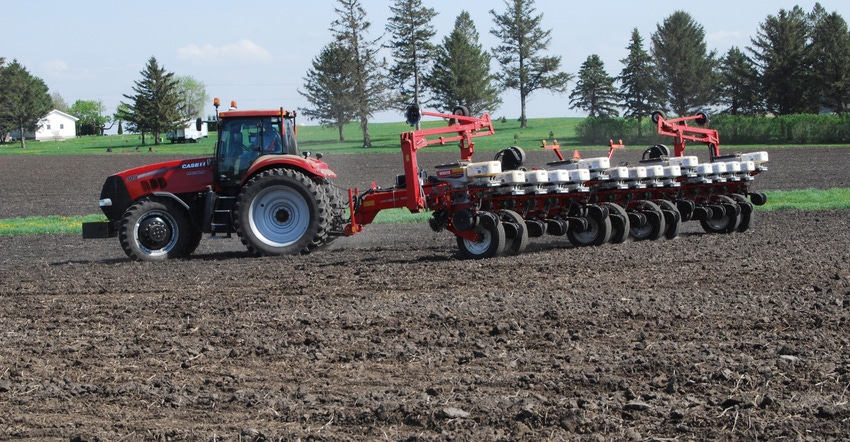April 10, 2020

Preparations for planting across Iowa are in full swing. Anhydrous applicators have been running in fields this week — likewise, for dry fertilizer applicators. Seed and other inputs are being delivered. Surrounded by uncertainty as the global coronavirus pandemic is causing disruptions and tough economic times, Iowa farmers are preparing to plant corn and soybeans.
Weather-wise, spring 2020 is shaping up better than 2019. “Conditions over the last 30 days have been unseasonably warm across the Midwest, with temperatures anywhere from 2 to 4 degrees F above normal,” says Justin Glisan, state climatologist at the Iowa Department of Agriculture. “Early March had a good stretch of dry conditions, and the second half of the month experienced a more active storm track in which rain and some snow fell every few days. With the recent wetness, the last 30 days were wetter than normal.”
Better outlook than last spring
Soils remain wet with a full subsoil moisture supply carried over from fall 2019, which was the seventh wettest in 148 years of statewide records, following the 12th wettest year on record. “There is a silver lining, though,” Glisan says. “Conditions moving into the 2020 planting season are better than they were at this time last year. And the above-average temperatures and some windy days this spring also helped to dry the soil beginning in early March.”
Looking at the Climate Prediction Center’s short-term outlook into mid-April indicates high probability of unseasonable coldness with a slight chance of wetter-than-normal conditions. These colder-than-normal temperatures shouldn’t impact row crops since corn and soybean planting hasn’t started quite yet. But specialty horticulture crops may be impacted as well as forage crops.
“For forage crops like alfalfa, there is potential to see some frosted leaves in established stands, but plants should be fine,” says Rebecca Vittetoe, Iowa State University Extension field agronomist. “New alfalfa seedings that may be up and beginning to grow have very good frost tolerance due to two main factors. One is their proximity to the soil and the soil’s radiant heat relative to the colder air temperatures. The other is that seedlings have a rather high concentration of sugars and other compounds in the cells that help lower its freezing point.”
Evaluating frosted alfalfa stands
“If new seedings of alfalfa are frost-damaged, they will first appear to wilt and then die over the following three to five days,” Vittetoe says. “As long as at least one set of leaves escapes damage, the plant should recover. Wait a week after the frost and estimate the number of living plants per square foot. If more than 20 plants per square foot remain, the stand will survive in good shape. If there are fewer than 15 plants per square foot, consider interseeding more alfalfa into the stand.”
For the remainder of April, the weather outlook from CPC shows a slight decrease in the probability of wetter-than-normal conditions, which were in the initial April outlook released in mid-March. The forecast also suggests higher chances of warmer-than-normal temperatures for much of Iowa. “What we see in the April outlook is mirrored in the April-May-June outlook. That is, elevated chances of warmer and wetter conditions,” Glisan says.
Working wet soil
Farmers should be mindful of soil conditions before pulling into fields to plant or to work ground ahead of planting, given the current wetness across much of Iowa. “Compaction issues are still a concern,” Vittetoe says. “Soil temperatures have been trending up across the state recently. Taken as a whole, farmers should be ready to go when short-term weather outlooks and forecasts show windows of favorable weather.”
Weather continues to have the biggest impact on planting plans for 2020, just as it did in 2019. “We’ve already missed our chance for an early planting season,” says ISU cropping systems agronomist Mark Licht. “Now it’s a question of whether we’ll see normal or late planting.”
Licht estimates with good planting conditions, Iowa farmers can plant about 1 million acres per day. USDA’s prospective planting estimate released last week projects Iowa farmers will plant 14.1 million acres of corn this year and 9.3 million acres of soybeans. Given these estimates, Licht says Iowa farmers need to find 23 to 25 “suitable” days by mid-May to get the crop planted.
The USDA planting intentions report indicates farmers nationally intend to plant 97 million acres of corn and 83.5 million acres of soybeans this spring. That’s 7.3 million more corn acres than in 2019, a projected 8% year-over-year increase.
However, this 2020 planting intentions survey was taken earlier in May, before COVID-19 uncertainty clouded the crop price outlook. USDA’s survey projection of 83.5 million acres of soybeans in 2020 is up 7.4 million acres from 2019. Last year’s lower soybean acreage was a result of delayed spring planting and adverse price impacts from retaliatory tariffs applied by China.
About the Author(s)
You May Also Like






